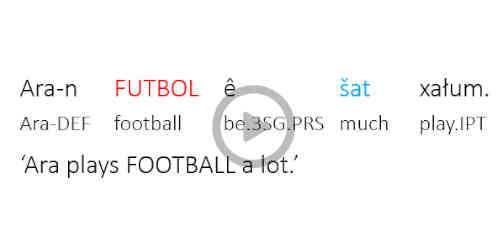Stony Brook University
Inalco, SeDyL, CNRS
University of Cambridge
Inalco, SeDyL, CNRS, IRD
Word order and information structure
by K. Hodgson & V. Khurshudyan

DOI: https://doi.org/10.5281/zenodo.5891448
basic word order, OV/VO, information structure, sentential stress, topics, foci, head-final/head-initial constituents, factors favouring VO
slides
Cowe, S. P. 1992. Amēn teł hay kay: Armenian as a pluricentric language. In Michael Clyne (ed.), Pluricentric Languages (pp. 325-346). De Gruyter Mouton.
Donabedian, A., 2013, L’arménien occidental. In G. Kremnitz (ed.), Histoire sociale des langues de France (pp. 609-618). Rennes : PUR.
Donabedian A. & I. Sitaridou 2020. Anatolia, In E. Adamou & Y. Matras (eds.), The Routledge Handbook of Language Contact pp. 404-433. Abingdon, Oxon: Routledge (ms available; publisher's website).
Abrahamyan, S. 2004. Hayoc῾ lezu։ Šarahyusut῾yun [Armenian language: Syntax]. Yerevan: Luys.
Acharyan, H. 1961. Liakatar kherakanuthjun hajoch lezvi [The Complete Grammar of the Armenian Language], v. 4b, Yerevan, 173-201.
Arakelyan, V. 1958. Hayereni šarahyusut῾yun [Armenian Syntax]. v. 1, Yerevan.
Asatryan, M. E. 2004. Žamanakakic῾ hayoc῾ lezu։ J̌evabanut῾yun [Modern Armenian language: Morphology]. Yerevan: Yerevan State University Press.
Donabédian, A. 2018. Western Armenian at the crossroads: A sociolinguistic and typological sketch. In C. Bulut (ed.) Linguistic Minorities in Turkey and Turkic-speaking minorities of the peripheries (pp. 89-148). Wiesbaden: Harrassowitz.
Dum-Tragut, J. 2009. Armenian: Modern Eastern Armenian. Amsterdam/Philadelphia: John Benjamins.
Fairbanks, G. H. 1948. Phonology and morphology of modern spoken West Armenian. Madison: University of Wisconsin.
Johnson, E. W. 1954. Studies in East Armenian Grammar. Berkeley: University of California.
Vaux, B. 2007. Homshetsma: The language of the Armenians of Hamshen. In H. Simonian (ed.), The Hemshin (pp. 257-278). Abingdon & New York: Routledge.
Vaux, B. 1998. The phonology of Armenian. Oxford University Press.
Baronian, L. 2017. Two problems in Armenian phonology. Language and Linguistics Compass, 11(8), e12247.
Dolatian, H. 2021. Cyclicity and prosodic misalignment in Armenian stems. Natural Language & Linguistic Theory 39(3), 843-886.
Dolatian, H. 2021. The role of heads and cyclicity in bracketing paradoxes in Armenian compounds. Morphology 31(1), 1-43.
Hacopian, N. 2003. A three-way VOT contrast in final position: Data from Armenian. Journal of the International Phonetic Association 33(1), 51-80.
Seyfarth, S., & Garellek, M. 2018. Plosive voicing acoustics and voice quality in Yerevan Armenian. Journal of Phonetics, 71, 425-450.
Kelly, N. E., & Keshishian, L. 2021. Voicing patterns in stops among heritage speakers of Western Armenian in Lebanon and the US. Nordic Journal of Linguistics, 1-27.
Boyacioglu, N. & H. Dolatian. 2020. Armenian Verbs: Paradigms and verb lists of Western Armenian conjugation classes (v.1.0.0). Zenodo. https://doi.org/10.5281/zenodo.4397423
Daniel, M. & V. Khurshudian. 2015. Valency classes in Eastern Armenian. In A. Malchukov and B. Comrie (eds.), Valency Classes in the World’s Languages (pp. 483–540). Berlin/New York: De Gruyter.
Dolatian, H. & P. Guekguezian. 2021. Relativized Locality: Phases and Tiers in Long-Distance Allomorphy in Armenian. Linguistic Inquiry doi: https://doi.org/10.1162/ling_a_00456.
Donabédian, A. 1997. Neutralisation de la diathèse des participes en-acde l’arménien mod-erne occidental. Studi italiani di linguistica teorica ed applicata 26(2), 327–339.
Donabédian, A. 2001. Toward a Semasiological account of Evidentials: an Enounciative Approach of er in Modern W. Armenian. Journal of Pragmatics 33(3), 421-442.
Donabedian, A. 2016. The aorist in Modern Armenian. In Guentchéva, Z. (ed.), Aspectuality and Temporality: Descriptive and theoretical issues (pp. 375–412). Amsterdam: Benjamins.
Donabédian-Demopoulos, A. 2010. Nom nu et tropisme typologique: le cas de l’arménien. In F. Floricic (ed.), Essais de typologie et de linguistique générale, mélanges offerts à Denis Creissels (pp. 403-416). Lyon: ENS.
Gevorgyan, G. 1994. The Continuous Present in Armenian Dialects. Annual of Armenian Linguistics 15, 43-62.
Hewitt, B. G. 1978. The Armenian Relative Clause. International Review of Slavic Linguistics 3, 99-138.
Hodgson, K. 2019. Discourse Configurationality and the Noun Phrase in Eastern Armenian. Faits de Langues 50(2), 137-166.
Hodgson, K. 2019. Relative clauses in colloquial Armenian: Syntax and typology. INALCO PhD thesis.
Hodgson, K. (forthcoming). Non-syntactic factors and accessibility to relativization: evidence from Armenian. Accepted by Linguistics.
Kahnemuyipour, A. & K. Megerdoomian. 2011. Second Position Clitics and the vP Phase: The Case of the Armenian Auxiliary. Linguistic Inquiry 42, 152–162.
Kahnemuyipour, A. & K. Megerdoomian. 2017. On the Positional Distribution of an Armenian Auxiliary: Second‐Position Clisis, Focus, and Phases. Syntax 20(1), 77–97.
Kalomoiros, A. 2021. Bare singulars and pseudo-incorporation in Western Armenian. Proceedings of SALT 31, 365–384.
Khanjian, H. 2013. (Negative) concord and head directionality in Western Armenian. Doctoral dissertation, Massachusetts Institute of Technology.
Kozintseva, N. 1995. The Tense System of Modern Eastern Armenian. In Thieroff, R. (ed.), Tense Systems in European Languages, v. 2 (pp. 277-298). Tübingen: Niemeyer.
Kowal, B. 1992. East Armenian relative clauses. In C- Paris (ed.), Caucasologie et mythologie comparée, Actes du Colloque international du C.N.R.S. – IVe Colloque de Caucasologie (pp. 431-439). Paris: Peeters.
Plungian, V. 2006. K opisaniju armjanskoj glagol’noj paradigmy: “temporal’naja podvidznost’” i perfektiv [On the description of Armenian verb paradigm: “Temporal mobility” and perfective]. Armjanskij gummanitarnyj vestnik, 2006, # 1, 7–20.
Sakayan, D. 1993. On Armenian relative participles and their access to AH. In Proceedings of the XVth International Congress of Linguists, Université Laval, 1992, vol. 2 (pp. 361-364). Québec: Université Laval Press.
Samvelian, P., P. Faghiri & V. Khurshudyan (to appear). On the persistence of SVO: The case of Modern Eastern Armenian. To appear in Linguistics.
Sigler, M. 1996. Specificity and Agreement in Standard Western Armenian. Cambridge, MA: MIT PhD thesis.
Tamrazian, A. 1994. The Syntax of Armenian. Chains and the Auxiliary. London: University College London PhD Thesis.
Vaux, B. 1995. A Problem in Diachronic Armenian Verbal Morphology. In Weitenberg, J.J.S (ed.), New Approaches to Medieval Armenian Language and Literature (pp. 135-148). Amsterdam.
Hagopian, G. 2005. Armenian for everyone: Western and Eastern Armenian in parallel lessons. Academic Resources Corporation.
You may be interested for the online course on Classical Armenian by Ronald Kim and Daniel Kölligan.